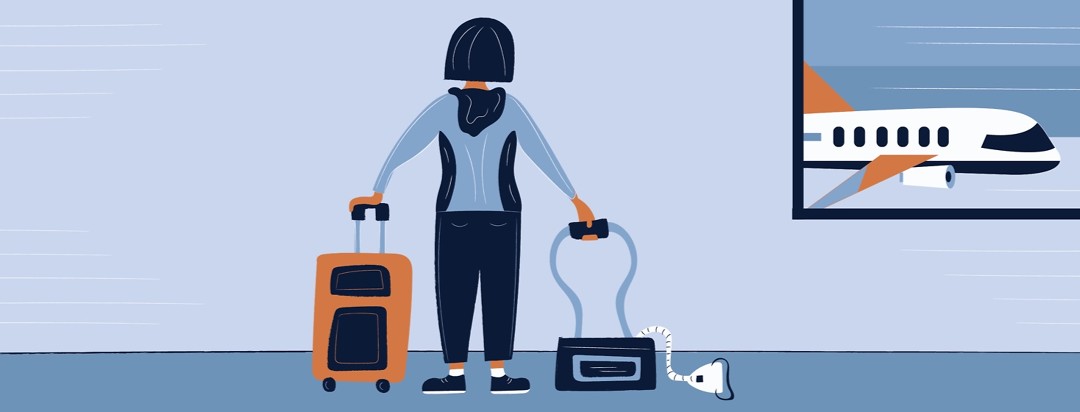Travels With CPAP: Making the Best of the TSA Line
I’ve used positive airway pressure (PAP) therapy for my moderate obstructive sleep apnea for over 3 years now. In that time, I’ve traveled by plane from Seattle to Phoenix, Philadelphia, Honolulu/Lihue, Boston, and Indianapolis, then back again.
I’ve also traveled to and from Portland, Oregon, by Amtrak and made multiple weekend trips into Victoria, British Columbia, taking the Black Ball Ferry Line as a walk-on passenger.
In each and every case, I’ve packed my PAP.
If you’re new to traveling with CPAP, read on for experiences, insights, and tips.
Tales from the TSA
I remember worrying about carrying my PAP equipment onto the plane. I also bring my laptop and a backpack with my multiple sclerosis meds. Simple math says I have 1 more thing to carry on than what’s normally allowed.
Repeat after me: PAP is a medical device. By federal mandate law, passengers are allowed to take and use all medical devices on airplanes. The Transportation Security Administration (TSA) knows this, encourages it, and enforces the rule. This means you’re still granted 2 carry-ons like everyone else, plus your CPAP.
Don't worry about going through security
Here’s what you can expect: You’ll need to open your PAP case and place it in its own tray on the security belt. The x-ray agent will pause to look at it, then forward without comment.
Will the agent inspect my machine?
It’s hit or miss whether they’ll inspect your PAP machine. It may depend on how busy the terminal is. If your PAP equipment is pulled over for inspection, pay attention! Here are 2 things I’ve encountered:
- They must put on fresh gloves before handling your equipment. This is critical… you don’t want a million airport travelers’ germs on your CPAP (continuous positive airway pressure machine)! If they don’t change their gloves, demand that they do. Sometimes they forget (though, during a pandemic, that seems less likely). If they aren’t wearing gloves at all, demand that they do.
- They’ll remove and inspect all parts of your CPAP plus the bag. This is fine. What’s not fine? Taking parts out and then not replacing them. I lost a short PAP mask tube this way. I didn’t discover the loss until I got home. Fortunately, I keep spares on hand. Had I been on the road, my PAP would’ve been rendered useless. The lesson here: Inventory your gear at the security checkpoint before heading to your gate to ensure you have all your items.
Can I bring water through security?
Yes, you can bring water for your PAP machine with you on the plane: sealed small TSA-approved water bottles containing distilled water for PAP usage. Store the water in the CPAP bag's side pocket or pack it in your checked luggage – the heavier plastic used in the bottles withstands pressure changes.
- But! Be prepared for pushback on CPAP water: Poorly trained TSA clerks might remove a label in order to get a scan or question your bottles. Show them the TSA label; they should allow it. Remember, as a necessary part of your medical therapy, it cannot be rejected. I’ve carried TSA-approved water on flights more times than I can count.
- If you’re on an intercontinental, international, red-eye, or transcontinental coast-to-coast flight, you may need to use your therapy. Don’t be afraid! People hardly notice. In fact, they’ll more likely notice the person snoring loudly enough to be heard from 5 rows away.
PAP by land and by sea
If you’re taking a trip by train or bus, keep your PAP machine with you. Ferries usually allow you to keep all your belongings with you.
Other CPAP travel tips
- Inventory your PAP parts before leaving home. Keep your equipment provider’s contact information handy in case you forget, lose, or break something. I once left a gasket at home – never again!
- You no longer need prior approval from airlines to pack or use PAP, nor do you need to tag your gear as medical equipment.
- To carry your gear hands-free, use a bag with a side strap that allows you to slide it over the telescoping handle on your luggage. You’re less likely to lose your PAP in transit. A roomy soft-sided backpack can also accommodate your PAP gear and other items. I know, it’s a bag inside a bag, but it keeps everything in 1 place.
- As soon as you arrive at your destination, or if you use your PAP while flying, clean and disinfect your equipment right away.
- Pack extra travel-sized cleaning wipes, mask cushions, even spare tubing in your checked luggage. Mask cushions can tear and tubing can get holes at the most inconvenient times!
- Finally, pack an extension cord for rooms with limited outlets. Choose a cord that fits older outlets. For international travel, an adapter or converter may be necessary.
How do you travel with your CPAP? Join our community and share in the comments below!
Interested in learning more CPAP tips and tricks? Explore our featured collection just for CPAP users.

Join the conversation